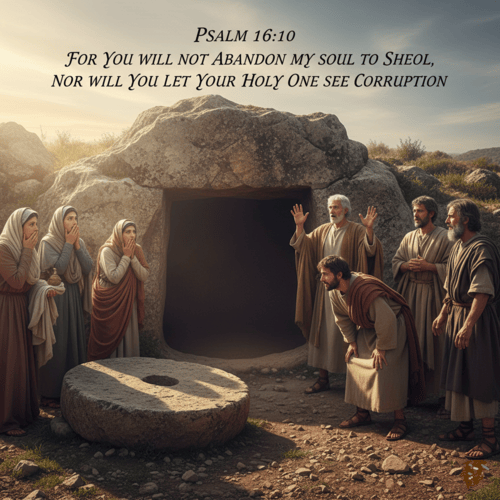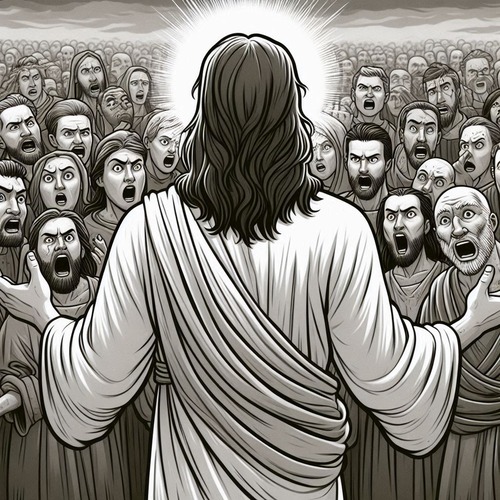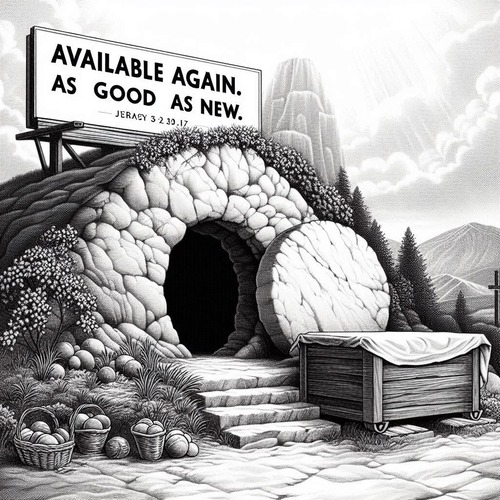The Cross and Yom Kippur: How Jesus Fulfils the Day of Atonement
The Day of Atonement (Yom Kippur) is a solemn day in the ancient Jewish calendar—a day when the high priest would enter the Holy of Holies to make atonement for the sins of Israel. Yet, this sacred ritual, commanded by God Himself, was never meant to be an end in itself—but rather a shadow pointing to a greater reality to come. This reality finds its perfect fulfillment in the person and work of Jesus Christ (Hebrews 9:24)…
YOM KIPPUR IN THE OLD TESTAMENT
The Day of Atonement was instituted in Leviticus 16: God provides detailed instructions to Moses following the deaths of Aaron’s sons who approached the Lord inappropriately. This solemn day—the tenth day of the seventh month (Tishri)—served as the annual cleansing of Israel’s sins (Leviticus 16:2, 34).
This was no ordinary ceremony but the pinnacle of Israel’s sacrificial system. It addressed what the daily sacrifices could not fully resolve—the accumulated defilement that threatened Israel’s covenant relationship with God. On this day, the high priest alone could enter God’s most holy presence, and only with blood.
The High Priest’s Role
The high priest underwent extensive preparations for this momentous occasion. Typically adorned in gold-embroidered garments that displayed glory and beauty (Exodus 28), the high priest would set these aside and wear only white linen garments after washing his body (Leviticus 16:4). The change in attire symbolised the purity and humility required to approach God’s presence. The high priest bore the tremendous burden of representation—standing before God on behalf of the entire nation. One misstep in this ritual could result in death, highlighting the seriousness of sin and the holiness of God.
The Sacrificial Elements
The Day of Atonement required specific sacrifices, each with profound significance:
- The bull for the priest’s own sin: Before representing others, the high priest had to address his own sinfulness (Leviticus 16:6).
- The two goats: Central to this day were two goats, selected by lot. One “for the Lord” was sacrificed as a sin offering, its blood sprinkled on the mercy seat. And one was designated as the “scapegoat” (azazel) that symbolically carried away the people’s sins (Leviticus 16:21).
- The blood that makes atonement: Throughout this ritual, blood played a central role (Leviticus 17:11).
The Holy of Holies
The innermost sanctuary of the tabernacle, separated by a thick veil, contained the ark of the covenant topped by the mercy seat (kapporeth). This sacred space represented God’s very throne room, the place of His special presence. Access was severely restricted—only the high priest could enter, and only once a year with blood (Hebrews 9:8). The limited access powerfully communicated Israel’s separation from God due to sin. Simultaneously, it also preserved hope for a future, more perfect communion with Him.
THE CROSS AND YOM KIPPUR: CHRIST AS THE PERFECT HIGH PRIEST
Superior to the Levitical Priesthood: Where the Levitical priesthood was temporary and flawed, Christ stands as the perfect and eternal High Priest (Hebrews 7:26-27).
The book of Hebrews declares Christ’s priesthood superior on multiple grounds:
- It follows the order of Melchizedek, not Aaron (Hebrews 7:11-17)
- It is established by God’s oath, not merely legal requirement (Hebrews 7:20-22)
- It continues forever, uninterrupted by death (Hebrews 7:23-25)
- It is exercised by One who is sinless (Hebrews 4:15)
The Perfect Mediator: Christ uniquely qualifies as the perfect mediator between God and man (1 Timothy 2:5-6). His mediation exceeds that of the Levitical priests because as fully God, He perfectly represents divine holiness and justice. As fully man, He authentically represents humanity. And, unlike the high priest who entered God’s presence trembling, Christ entered by right. He can “sympathise with our weaknesses” having been “tempted in every respect as we are, yet without sin” (Hebrews 4:15)
His Perfect Preparation: Where the Levitical high priest underwent external washings and donned special garments, Christ’s preparation was His perfect life of obedience:
- His baptism and identification with sinners, though sinless Himself (Matthew 3:13-17)
- His testing in the wilderness, overcoming where Israel had failed (Matthew 4:1-11)
- His lifelong obedience as the Second Adam, fulfilling what the first Adam could not (Romans 5:12-21)
- His submission in Gethsemane—”not my will, but yours, be done” (Luke 22:42)
Thus, when Christ approached the cross, He did so not as one requiring purification, but as the perfectly pure sacrifice.
THE CROSS AND YOM KIPPUR: CHRIST AS THE PERFECT SACRIFICE
The Lamb of God: John the Baptist declaration of Jesus as “the Lamb of God, who takes away the sin of the world” (John 1:29) connects Christ to the entire sacrificial system, particularly the Passover lamb and the Day of Atonement sacrifices. Christ was a “lamb without blemish or defect” (1 Peter 1:19). He was “foreknown before the foundation of the world” (1 Peter 1:20). And He voluntarily offered Himself: “No one takes it from me, but I lay it down of my own accord” (John 10:18).
The Fulfillment of Both Goats: On the Day of Atonement, two goats were required to fully symbolise atonement. Christ fulfils both roles:
- The sacrificial goat: His blood was shed at Calvary, making atonement for sin (Ephesians 1:7).
- The scapegoat: He bore our sins away, removing them from God’s sight (1 Peter 2:24).
Isaiah prophesied this dual role: “The LORD has laid on him the iniquity of us all… he was cut off from the land of the living, stricken for the transgression of my people” (Isaiah 53:6, 8).
The Once-for-All Sacrifice: The annual repetition of the Day of Atonement revealed its inadequacy. The letter to the Hebrews emphasises the finality and completeness of Christ’s sacrifice (Hebrews 9:11-12 and Hebrews 10:14). It accomplished what the blood of bulls and goats could not—the actual removal of sin, not merely its ceremonial covering. His cry of “It is finished” (John 19:30) declared the end of the sacrificial system.
THE CROSS AND YOM KIPPUR: CHRIST ENTERS THE TRUE HOLY OF HOLIES
The Temple Veil Is Torn: At the moment of Christ’s death, a profound sign occurred (Matthew 27:51). This supernatural rending of the veil separating the Holy Place from the Most Holy Place declared the end of separation between God and His people, and of the Levitical priesthood. It also ushered in a new and living way of access to God through Christ (Hebrews 10:19-20, 22).
Entrance into Heaven Itself: Where the Levitical high priest entered a man-made sanctuary, Christ entered heaven itself (Hebrews 9:24). This entrance emphasises:
- The earthly tabernacle was merely a “copy and shadow” (Hebrews 8:5)
- Christ ministers in “the greater and more perfect tent (not made with hands)” (Hebrews 9:11)
- His priestly work continues as He “always lives to make intercession” for His people (Hebrews 7:25)
The Mercy Seat Fulfilled: The Greek term used in Romans 3:25 for Christ as our “propitiation” (Greek: hilasterion) is the same word used in the Septuagint for the mercy seat—the lid of the ark where blood was sprinkled on the Day of Atonement. This identification reveals Christ Himself is the place of atonement, where God’s righteous wrath against sin is satisfied. Mercy and justice meet perfectly at the cross. And the demands of the law (represented by the tablets inside the ark) are fulfilled.
THE CROSS AND YOM KIPPUR: THE REFORMED UNDERSTANDING
Limited/Particular Atonement: While the value of Christ’s atonement is infinite, its intention was particular—for God’s elect (John 10:11, 15). This doctrine of particular redemption aligns with Christ’s own words about the purpose of His death (Mark 10:45 and Matthew 26:28). The particular atonement flows naturally from God’s eternal purpose in election (Ephesians 1:4-5).
Effectual Atonement: Christ’s atonement actually secures salvation for His people, not merely making it possible. His work effectively accomplishes what it intends (John 6:37, 39). The atonement isn’t merely potential or dependent on human choice to become effective as some believe. Rather, Christ’s sacrifice actually redeems (Galatians 3:13); reconciles (2 Corinthians 5:18-19); propitiates (1 John 2:2) and saves (Matthew 1:21).
Union with Christ: Believers are united with Christ in His atoning work (Romans 6:4). This union means His death becomes our death to sin. His resurrection becomes our resurrection to new life. His entrance into God’s presence becomes our entrance. As our covenant head and representative, what Christ accomplished is credited to all who’re in Him by faith.
Sovereign Grace: The application of Christ’s atonement depends not on human will but on God’s sovereign grace (Romans 9:16; John 6:44). This sovereign work involves the Father’s election of a people for Himself, the Son’s redemption of those given to Him, and of course, the Spirit’s regeneration and application of Christ’s benefits. Salvation, in this trinitarian work, is secured from beginning to end, guaranteeing that all for whom Christ died will come to saving faith (Romans 8:30).
CONCLUSION: THE CROSS AND YOM KIPPUR
What was shadowed in the solemn rituals of Yom Kippur finds its radiant fulfillment in the person and work of Jesus Christ. The annual Day of Atonement with its temporary priests, animal sacrifices, and restricted access to God’s presence has given way to the eternal reality of our Great High Priest who offered Himself once for all. Christ has torn the veil, entered heaven itself, and secured an eternal redemption for His people. No longer must we wonder if atonement has been accomplished or if our sins are truly forgiven. In Christ, we have absolute assurance that God’s justice is satisfied and His mercy is secured. The blood that flowed at Calvary speaks a better word than the blood of bulls and goats—it speaks the final word of reconciliation between God and His elect. This is the glory of the gospel: what was prefigured in shadows has now been perfectly fulfilled in substance.
Soli Deo Gloria—to God alone be the glory.
THE CROSS AND YOM KIPPUR: RELATED FAQs
Should Christians observe Yom Kippur today? Christians aren’t required to observe Yom Kippur as a religious obligation. Christ has fulfilled what Yom Kippur foreshadowed, making its observance unnecessary. Hebrews 10:1 teaches the law had “a shadow of the good things to come instead of the true form of these realities.”. While we may study Yom Kippur to better understand Christ’s work, we’re free from ceremonial law obligations.
How can we reconcile universal gospel offers with particular redemption? God genuinely offers salvation to all who hear the gospel, even while Christ’s atonement was intended for His elect. This reflects the distinction between God’s revealed will (the command to repent and believe) and His decreed will (His sovereign purpose in election). The gospel is to be preached to all people without distinction, though it will be effective only for those whom the Father has given to the Son. We proclaim “Christ crucified” indiscriminately, trusting the Holy Spirit will apply this message effectually to God’s chosen people.
Does Hebrews 10:26-31 mean true believers can lose their salvation? These warning passages are means by which God preserves His elect, not evidence that true believers can fall away. Those who ultimately apostatise demonstrate they were never truly regenerate (1 John 2:19). The same book that warns against apostasy affirms Christ has “perfected for all time those who are being sanctified” (Hebrews 10:14). Perseverance of the saints means God preserves His own through various means, including these solemn warnings.
Why do we need Jesus as our High Priest if we can approach God directly? While believers have direct access to God, we still require a mediator because of our continuing sin and God’s perfect holiness. Christ’s ongoing intercession as our High Priest (Hebrews 7:25) is essential to our relationship with God. Our direct access exists precisely because Christ serves as our permanent High Priest in the heavenly sanctuary. We come “boldly to the throne of grace” only because our Great High Priest has gone before us.
How should the doctrine of Christ’s atonement shape our worship? Christ’s fulfillment of Yom Kippur should produce deep gratitude and reverence in our worship. The Lord’s Supper particularly reminds us of the blood of the new covenant shed for the forgiveness of sins. Our worship should be characterised by both solemnity (recognising the cost of atonement) and joy (celebrating our assured redemption). Since Christ has torn the veil, we worship with confidence rather than fear, yet maintaining appropriate reverence.
If Christ’s atonement was limited to the elect, how can we sincerely evangelise? We evangelise sincerely because God commands it, Christ is worthy of it, and we don’t know who the elect are. The doctrine of election actually provides hope in evangelism—God has His people who will respond when the gospel is proclaimed. We can confidently declare “Christ saves sinners” knowing those who come to Him in faith will not be cast out. The effectiveness of evangelism depends not on human persuasion but on God’s sovereign grace, freeing us to proclaim truth faithfully.
How does understanding Yom Kippur enhance our appreciation of Christ’s work? Understanding Yom Kippur provides the theological background necessary to grasp the significance of Christ’s sacrificial death. The intricate details of the Day of Atonement ritual—the blood, the scapegoat, the Holy of Holies—illuminate different aspects of Christ’s comprehensive work. Without this background, we may miss the depth of what it means for Christ to be both our High Priest and our sacrifice. This typological connection affirms God’s consistent redemptive plan throughout history, culminating in Christ.
THE CROSS AND YOM KIPPUR: OUR RELATED POSTS
- Is Jesus the Jewish Messiah? Seven Arguments You Can’t Ignore
- Jesus in the Old Testament: Glimpses of the Coming Saviour
- Types of Christ and His Cross in the Old Testament
Editor's Pick

No Decay, No Defeat: What It Means That Christ’s Body Saw No Corruption
On the Day of Pentecost, Peter stood before thousands and made a startling claim: David's body decayed in the tomb, [...]

GPS Without Eyes: How Ants Silently Shout Intelligent Design
Picture a leafcutter ant navigating the rainforest floor in pitch darkness, carrying a leaf fragment 50 times its body weight. [...]

Does God Truly Care About My Everyday Choices?
We believe God created the universe. We believe He orchestrated the exodus from Egypt and raised Jesus from the dead. [...]
SUPPORT US:
Feel the Holy Spirit's gentle nudge to partner with us?
Donate Online:
Account Name: TRUTHS TO DIE FOR FOUNDATION
Account Number: 10243565459
Bank IFSC: IDFB0043391
Bank Name: IDFC FIRST BANK






